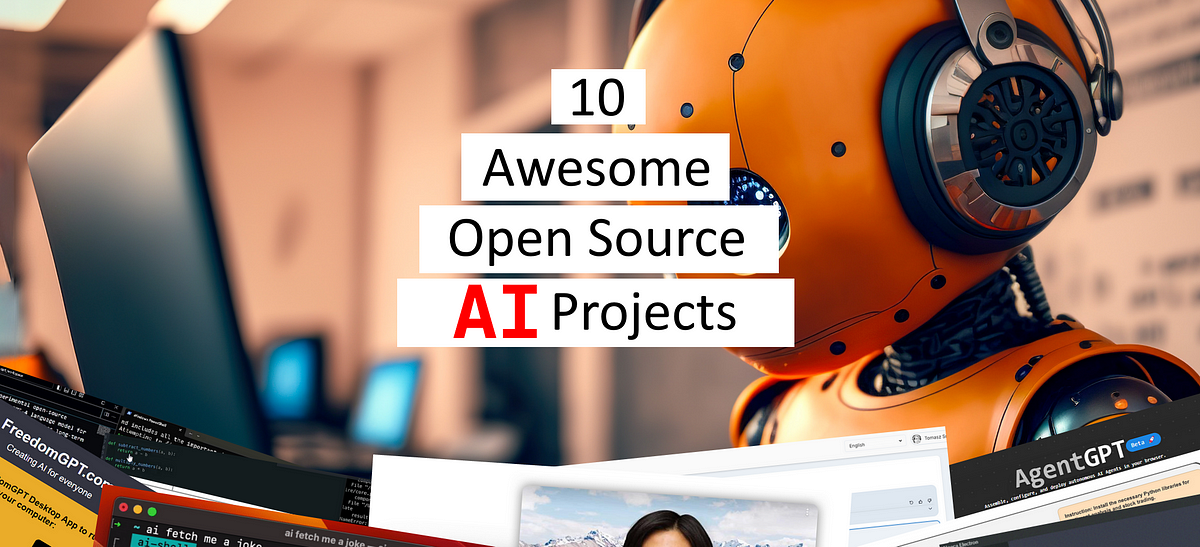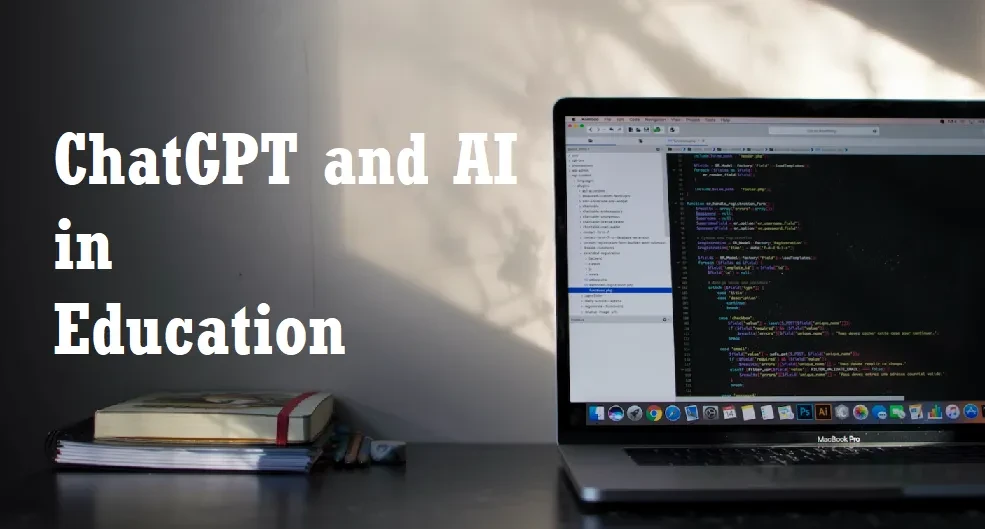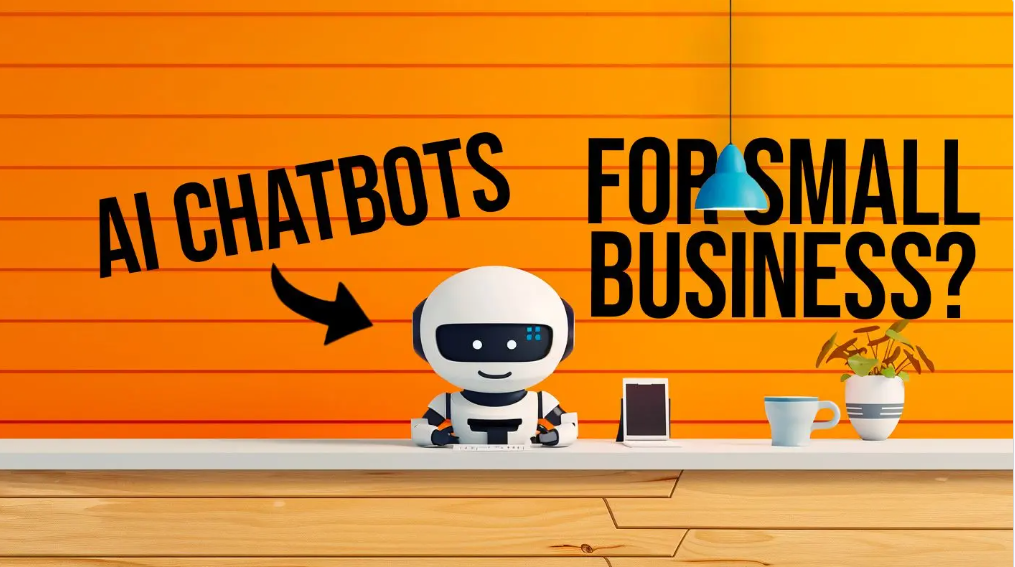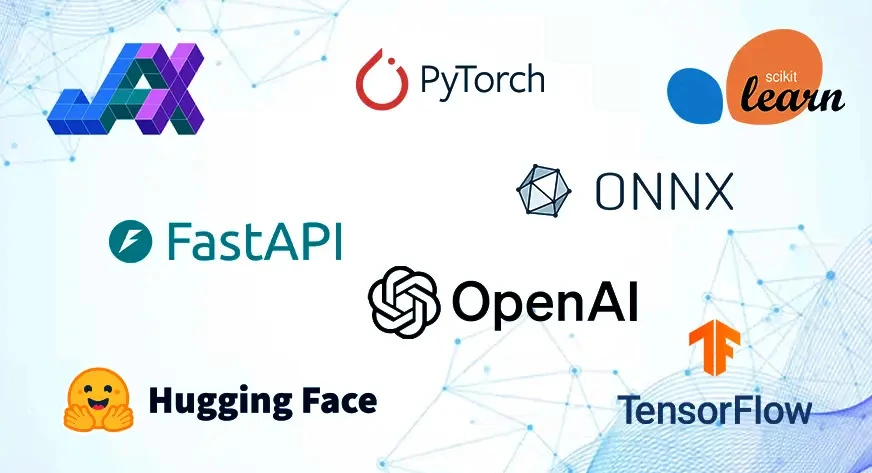Przetestuj AI na TWOJEJ stronie w 60 sekund
Zobacz, jak nasza sztuczna inteligencja błyskawicznie analizuje Twoją stronę internetową i tworzy spersonalizowanego chatbota - bez rejestracji. Po prostu wprowadź swój adres URL i obserwuj, jak działa!
Wprowadzenie: Złoty wiek otwartej sztucznej inteligencji
Projekty open source AI przekształciły się z akademickich ciekawostek w gotowe do produkcji narzędzia zasilające aplikacje w różnych branżach. Udemokratyzowały dostęp do najnowocześniejszej technologii, umożliwiły personalizację, której nie mogą dorównać zastrzeżone systemy, i stworzyły tętniące życiem społeczności, które przyspieszają dzielenie się wiedzą i innowację.
W tym artykule omówiono dziesięć najbardziej imponujących obecnie projektów open source AI. Projekty te wyróżniają się nie tylko swoimi możliwościami technicznymi, ale także wpływem na szerszy ekosystem AI, innowacyjnymi podejściami do rozwiązywania złożonych problemów i potencjałem kształtowania przyszłości rozwoju sztucznej inteligencji.
Od dużych modeli językowych rywalizujących z ofertami komercyjnymi po specjalistyczne narzędzia rozwiązujące określone problemy z niezwykłą wydajnością, projekty te reprezentują najnowocześniejszy rozwój AI napędzany przez społeczność. Niezależnie od tego, czy jesteś badaczem uczenia maszynowego, programistą aplikacji, czy po prostu interesujesz się przyszłością technologii sztucznej inteligencji, oto projekty, którym warto się teraz przyjrzeć.
1. Hugging Face Transformers: Centrum sztucznej inteligencji Open Source
Dlaczego jest przełomowy
Sama biblioteka Transformers jest wystarczająco imponująca — zapewnia ujednolicony interfejs API do pracy z tysiącami wstępnie wyszkolonych modeli. Ale to, co czyni Hugging Face naprawdę rewolucyjnym, to jego szerszy ekosystem:
Model Hub: Dzięki ponad 150 000 bezpłatnie dostępnych wstępnie wyszkolonych modeli Hub stał się największym na świecie repozytorium współdzielonych modeli uczenia maszynowego, obejmujących język, wizję, dźwięk i aplikacje multimodalne.
Zestawy danych: Tysiące wyselekcjonowanych, kontrolowanych wersji zestawów danych do szkolenia i oceny modeli, rozwiązujących jedną z najpoważniejszych barier rozwoju AI.
Spaces: Infrastruktura do wdrażania interaktywnych demonstracji uczenia maszynowego, umożliwiająca każdemu prezentowanie działających aplikacji zbudowanych na otwartych modelach.
Współpraca w ramach przepływów pracy: oparta na Git kontrola wersji dla modeli i zestawów danych, dzięki której współpraca nad projektami AI jest tak samo usprawniona jak rozwój oprogramowania.
Wpływ na świat rzeczywisty
Hugging Face stało się kręgosłupem niezliczonych systemów AI produkcyjnych, od startupów po firmy z listy Fortune 500. Zapewniając kompleksową infrastrukturę dla całego cyklu życia uczenia maszynowego, radykalnie zmniejszyło bariery wdrażania zaawansowanych możliwości AI.
Nie można przecenić aspektu społeczności — Hugging Face stworzyło kulturę dzielenia się i współpracy, która przyspiesza demokratyzację AI. Naukowcy mogą dzielić się nowymi architekturami, praktycy mogą znaleźć specjalistyczne modele dla swoich przypadków użycia, a wszyscy korzystają ze zbiorowej wiedzy i zasobów.
Julien Chaumond, współzałożyciel Hugging Face, podkreśla to skupienie na społeczności: „Naszą misją jest demokratyzacja dobrego uczenia maszynowego. Sprawienie, aby wszyscy wnosili swój wkład i rozwijali pracę innych, jest najszybszą drogą do lepszej AI”.
Ważne funkcje i możliwości
Interfejs AutoClass: Automatycznie wybiera optymalny wstępnie wyszkolony model do określonych zadań, upraszczając implementację.
Karty modeli: Standaryzowana dokumentacja zapewniająca przejrzystość w zakresie możliwości, ograniczeń i uprzedzeń modelu.
Optymalna biblioteka: Narzędzia do optymalizacji wydajności modelu na różnych platformach sprzętowych.
Evaluation Harness: Standaryzowane testy porównawcze w celu porównania wydajności modelu.
Hugging Face Transformers ilustruje, w jaki sposób oprogramowanie typu open source może fundamentalnie przekształcić branżę, tworząc wspólną infrastrukturę, która przynosi korzyści całemu ekosystemowi AI.
2. LangChain: Tworzenie struktury dla aplikacji AI
Dlaczego jest przełomowy
LangChain zapewnia kompleksowe ramy do opracowywania aplikacji opartych na modelach językowych, rozwiązując krytyczną lukę między surowymi możliwościami AI a użytecznymi aplikacjami:
Łańcuchy kompozytowe: elastyczna architektura do łączenia wielu możliwości AI w spójne przepływy pracy.
Agenci: implementacja autonomicznych systemów AI, które mogą rozumować, planować i wykonywać zadania, wywołując różne narzędzia.
Systemy pamięci: różne metody utrzymywania kontekstu w konwersacjach i procesach w czasie.
Generowanie rozszerzone o pobieranie: narzędzia do uziemiania modeli językowych w określonych źródłach danych, radykalnie zwiększające ich dokładność i użyteczność dla aplikacji specyficznych dla domeny.
Zastosowanie narzędzi: standaryzowane interfejsy dla systemów AI do interakcji z aplikacjami zewnętrznymi, bazami danych i interfejsami API.
Wpływ na świat rzeczywisty
LangChain stał się niezbędną infrastrukturą dla tysięcy aplikacji AI, od automatyzacji obsługi klienta po platformy generowania treści i specjalistyczne narzędzia badawcze. Jego elastyczna architektura pozwala programistom na szybkie prototypowanie i iterowanie złożonych aplikacji AI, które w przeciwnym razie wymagałyby miesięcy niestandardowego rozwoju.
Projekt ilustruje, w jaki sposób oprogramowanie typu open source przyspiesza innowacje — poprzez dostarczanie standardowych komponentów dla typowych wzorców w rozwoju aplikacji AI, LangChain pozwala programistom skupić się na unikalnej wartości, zamiast odbudowywać podstawową infrastrukturę.
Harrison Chase, współzałożyciel LangChain, opisuje tę filozofię: „Naszym celem jest 10-krotnie szybsze tworzenie aplikacji AI, które są rzeczywiście przydatne. Oznacza to rozwiązywanie wszystkich otaczających problemów — łączenie się ze źródłami danych, utrzymywanie kontekstu, wykonywanie niezawodnych przepływów pracy — a nie tylko wykonywanie wywołań API do modeli językowych”.
Główne funkcje i możliwości
Ładowarki dokumentów: Wstępnie zbudowane łączniki dla dziesiątek źródeł danych, od plików PDF po strony internetowe i bazy danych.
Magazyny wektorowe: Integracje z bazami danych wektorowych dla możliwości wyszukiwania semantycznego.
Ustrukturyzowane dane wyjściowe: Narzędzia do niezawodnego wyodrębniania ustrukturyzowanych danych z nieustrukturyzowanego tekstu.
Ramka ewaluacyjna: Metody testowania i poprawy wydajności aplikacji.
LangChain pokazuje, w jaki sposób projekty open source mogą tworzyć zupełnie nowe kategorie i szybko stać się krytyczną infrastrukturą dla powstającej technologii.
3. LocalAI: wprowadzanie sztucznej inteligencji do Twojego sprzętu
Dlaczego jest przełomowy
LocalAI zapewnia kompletną platformę do lokalnego uruchamiania modeli AI, z architekturą, która stawia na dostępność i praktyczność:
Zgodność z API: Implementuje lokalnie interfejsy API zgodne z OpenAI, umożliwiając programistom przełączanie się między wdrożeniem w chmurze i lokalnym bez zmian w kodzie.
Model Zoo: Wstępnie skonfigurowany dostęp do szerokiej gamy otwartych modeli, od modeli językowych po generatory obrazów i przetwarzanie dźwięku.
Optymalizacja sprzętu: Automatyczna konfiguracja oparta na dostępnym sprzęcie, dzięki czemu modele działają wydajnie na wszystkim, od laptopów do gier po specjalistyczne urządzenia brzegowe.
Obsługa kwantyzacji: Wbudowane narzędzia do kompresji modeli w celu uruchomienia na ograniczonym sprzęcie przy zachowaniu akceptowalnej wydajności.
Projekt stawiający prywatność na pierwszym miejscu: Pełna suwerenność danych bez zewnętrznej komunikacji, umożliwiająca przypadki użycia, w których prywatność danych ma kluczowe znaczenie.
Wpływ na świat rzeczywisty
LocalAI umożliwiło zupełnie nowe kategorie aplikacji, w których oparta na chmurze sztuczna inteligencja byłaby niepraktyczna, od asystentów głosowych offline po wrażliwe na prywatność aplikacje medyczne i systemy przemysłowe w środowiskach bez niezawodnej łączności.
Dla deweloperów i organizacji zaniepokojonych prywatnością danych lub kosztami chmury LocalAI zapewnia praktyczną alternatywę, która zachowuje większość możliwości, jednocześnie rozwiązując te problemy. Jest to szczególnie cenne w regulowanych branżach, w których wymagania dotyczące zarządzania danymi utrudniają wdrażanie usług sztucznej inteligencji w chmurze.
Enrico Bergamini, kluczowy współpracownik LocalAI, podkreśla to podejście: „Sztuczna inteligencja powinna być dostępna dla każdego, nie tylko dla tych z ogromnymi budżetami na chmurę lub specjalistycznym sprzętem. Udowadniamy, że można uruchomić imponujące możliwości sztucznej inteligencji na sprzęcie, który już posiadasz”.
Główne funkcje i możliwości
Wdrażanie oparte na kontenerach: prosta konfiguracja przy użyciu Dockera w celu zapewnienia spójnego wdrażania w różnych środowiskach.
Whisper API: możliwości zamiany mowy na tekst, które działają całkowicie lokalnie.
Stabilna integracja dyfuzyjna: generowanie obrazu bez usług zewnętrznych.
Wsparcie multimodalne: możliwości tekstowe, graficzne, audio i wideo w ujednoliconym systemie.
LocalAI pokazuje, jak oprogramowanie typu open source może bezpośrednio rozwiązywać ograniczenia podejść komercyjnych, tworząc alternatywy, które priorytetyzują różne kompromisy i umożliwiają nowe przypadki użycia.
4. Ollama: Uproszczenie lokalnego wdrażania LLM
Dlaczego jest przełomowy
Ollama łączy wyrafinowanie techniczne z wyjątkową użytecznością, aby uczynić lokalną sztuczną inteligencję dostępną:
Instalacja w jednym wierszu: Rozpoczęcie wymaga tylko jednego polecenia, bez skomplikowanej konfiguracji ani zależności.
Biblioteka modeli: Wyselekcjonowana kolekcja zoptymalizowanych modeli, z których każdy ma inne kompromisy dotyczące możliwości i wymagań dotyczących zasobów.
Interfejs wiersza poleceń: Proste, intuicyjne polecenia do pobierania modeli i rozpoczynania konwersacji.
Serwer API: Wbudowany punkt końcowy API do integrowania lokalnych modeli z aplikacjami i przepływami pracy.
Zarządzanie modelami: Proste narzędzia do pobierania, aktualizowania i usuwania modeli.
Wpływ na świat rzeczywisty
Ollama radykalnie poszerzyła grono odbiorców lokalnych modeli sztucznej inteligencji, udostępniając je programistom, badaczom i entuzjastom, którzy w przeciwnym razie mogliby zostać zniechęceni przez złożoność techniczną. Przyspieszyło to eksperymenty i adopcję w wielu domenach.
Dla użytkowników i organizacji dbających o prywatność Ollama zapewnia praktyczny sposób eksploracji nowoczesnych możliwości AI bez wysyłania poufnych danych do usług zewnętrznych. Jej prostota sprawiła, że stała się szczególnie popularna w środowiskach edukacyjnych, gdzie umożliwia praktyczną naukę bez konieczności posiadania kont w chmurze lub specjalistycznego sprzętu.
Matt Schulte, współpracownik Ollama, wyjaśnia to podejście: „Chcieliśmy, aby uruchomienie lokalnego LLM było tak proste, jak instalacja dowolnej innej aplikacji. Technologia jest złożona, ale korzystanie z niej nie powinno takie być”.
Najważniejsze funkcje i możliwości
Dostosowywanie modelu: Narzędzia do tworzenia wyspecjalizowanych wersji modeli z niestandardowymi parametrami.
Zarządzanie kontekstem konwersacji: Utrzymuje kontekst między zapytaniami w celu zapewnienia naturalnych interakcji.
Przyspieszenie GPU: Automatyczne wykorzystanie dostępnych zasobów GPU w celu poprawy wydajności.
Obsługa multimodalna: Wykraczanie poza tekst w celu obsługi obrazów i innych typów danych.
Ollama ilustruje zasadę, że prawdziwie transformacyjna technologia staje się niewidoczna — dzięki czemu najnowocześniejsze możliwości AI wydają się być jak każde inne narzędzie na komputerze.
Przetestuj AI na TWOJEJ stronie w 60 sekund
Zobacz, jak nasza sztuczna inteligencja błyskawicznie analizuje Twoją stronę internetową i tworzy spersonalizowanego chatbota - bez rejestracji. Po prostu wprowadź swój adres URL i obserwuj, jak działa!
5. Mistral AI: wyznaczanie nowych standardów dla modeli otwartych
Meta Description: Discover the most groundbreaking open source AI projects that are pushing boundaries, democratizing advanced technology, and creating new possibilities for developers worldwide.
Introduction: The Golden Age of Open Source AI
We're living in an unprecedented era for artificial intelligence development. While commercial AI solutions continue to make headlines, the open source community has become an extraordinary force driving innovation, accessibility, and transparency in AI technology. These community-driven projects are not just alternatives to proprietary systems—in many cases, they're pushing the boundaries of what's possible and setting new standards for the entire industry.
Open source AI projects have transformed from academic curiosities into production-ready tools powering applications across industries. They've democratized access to cutting-edge technology, enabled customization that proprietary systems can't match, and created vibrant communities that accelerate knowledge sharing and innovation.
This article explores ten of the most impressive open source AI projects right now. These projects stand out not just for their technical capabilities but for their impact on the broader AI ecosystem, their innovative approaches to solving complex problems, and their potential to shape the future of artificial intelligence development.
From large language models rivaling commercial offerings to specialized tools solving specific problems with remarkable efficiency, these projects represent the cutting edge of community-driven AI development. Whether you're a machine learning researcher, an application developer, or simply interested in the future of AI technology, these are the projects worth watching right now.
1. Hugging Face Transformers: The Open Source AI Hub
Hugging Face Transformers has evolved from a simple NLP library into what many consider the GitHub for machine learning—a comprehensive ecosystem that's fundamentally changing how AI models are developed, shared, and deployed.
Why It's Groundbreaking
The Transformers library itself is impressive enough—providing a unified API for working with thousands of pre-trained models. But what makes Hugging Face truly revolutionary is its broader ecosystem:
Model Hub: With over 150,000 freely available pre-trained models, the Hub has become the world's largest repository of shared machine learning models, spanning language, vision, audio, and multimodal applications.
Datasets: Thousands of curated, version-controlled datasets for training and evaluating models, addressing one of the most significant barriers to AI development.
Spaces: An infrastructure for deploying interactive machine learning demos, enabling anyone to showcase working applications built on open models.
Collaborative Workflows: Git-based version control for models and datasets, making collaboration on AI projects as streamlined as software development.
Real-World Impact
Hugging Face has become the backbone of countless production AI systems, from startups to Fortune 500 companies. By providing a comprehensive infrastructure for the entire machine learning lifecycle, it has dramatically reduced the barriers to implementing advanced AI capabilities.
The community aspect cannot be overstated—Hugging Face has created a culture of sharing and collaboration that's accelerating the democratization of AI. Researchers can share new architectures, practitioners can find specialized models for their use cases, and everyone benefits from the collective knowledge and resources.
Julien Chaumond, co-founder of Hugging Face, emphasizes this community focus: "Our mission is to democratize good machine learning. Having everyone contribute and build on each other's work is the fastest path to better AI."
Notable Features and Capabilities
AutoClass Interface: Automatically selects the optimal pre-trained model for specific tasks, simplifying implementation.
Model Cards: Standardized documentation that provides transparency about model capabilities, limitations, and biases.
Optimum Library: Tools for optimizing model performance across different hardware platforms.
Evaluation Harness: Standardized benchmarking to compare model performance.
Hugging Face Transformers exemplifies how open source can fundamentally transform an industry, creating a shared infrastructure that benefits the entire AI ecosystem.
2. LangChain: Building the Framework for AI Applications
LangChain emerged to solve a critical problem: while foundation models provide impressive capabilities, building practical applications with them requires significant additional infrastructure. In just over a year, it has become the de facto standard for developing LLM-powered applications.
Why It's Groundbreaking
LangChain provides a comprehensive framework for developing applications powered by language models, addressing the critical gap between raw AI capabilities and useful applications:
Composable Chains: A flexible architecture for combining multiple AI capabilities into coherent workflows.
Agents: Implementation of autonomous AI systems that can reason, plan, and execute tasks by calling different tools.
Memory Systems: Various methods for maintaining context in conversations and processes over time.
Retrieval-Augmented Generation: Tools for grounding language models in specific data sources, dramatically improving their accuracy and usefulness for domain-specific applications.
Tool Usage: Standardized interfaces for AI systems to interact with external applications, databases, and APIs.
Real-World Impact
LangChain has become essential infrastructure for thousands of AI applications, from customer service automation to content generation platforms to specialized research tools. Its flexible architecture allows developers to rapidly prototype and iterate on complex AI applications that would otherwise require months of custom development.
The project exemplifies how open source accelerates innovation—by providing standardized components for common patterns in AI application development, LangChain lets developers focus on unique value rather than rebuilding basic infrastructure.
Harrison Chase, co-founder of LangChain, describes this ethos: "Our goal is to make it 10x faster to build AI applications that are actually useful. That means solving all the surrounding problems—connecting to data sources, maintaining context, executing reliable workflows—not just making API calls to language models."
Notable Features and Capabilities
Document Loaders: Pre-built connectors for dozens of data sources, from PDFs to web pages to databases.
Vector Stores: Integrations with vector databases for semantic search capabilities.
Structured Output: Tools for reliably extracting structured data from unstructured text.
Evaluation Framework: Methods for testing and improving application performance.
LangChain demonstrates how open source projects can create entirely new categories and rapidly become critical infrastructure for an emerging technology.
3. LocalAI: Bringing AI to Your Hardware
LocalAI represents a powerful movement in AI development—bringing sophisticated models to local hardware without requiring cloud services or expensive specialized equipment.
Why It's Groundbreaking
LocalAI provides a complete platform for running AI models locally, with an architecture that prioritizes accessibility and practicality:
API Compatibility: Implements OpenAI-compatible APIs locally, allowing developers to switch between cloud and local deployment without code changes.
Model Zoo: Pre-configured access to a wide range of open models, from language models to image generators to audio processing.
Hardware Optimization: Automatic configuration based on available hardware, making models run efficiently on everything from gaming laptops to specialized edge devices.
Quantization Support: Built-in tools for compressing models to run on limited hardware while maintaining acceptable performance.
Privacy-First Design: Complete data sovereignty with no external communication, enabling use cases where data privacy is critical.
Real-World Impact
LocalAI has enabled entirely new categories of applications where cloud-based AI would be impractical, from offline voice assistants to privacy-sensitive medical applications to industrial systems in environments without reliable connectivity.
For developers and organizations concerned about data privacy or cloud costs, LocalAI provides a practical alternative that maintains most capabilities while addressing these concerns. It's particularly valuable in regulated industries where data governance requirements make cloud AI services challenging to implement.
Enrico Bergamini, a key contributor to LocalAI, highlights this focus: "AI should be accessible to everyone, not just those with massive cloud budgets or specialized hardware. We're proving that you can run impressive AI capabilities on the hardware you already have."
Notable Features and Capabilities
Container-Based Deployment: Simple setup using Docker for consistent deployment across environments.
Whisper API: Speech-to-text capabilities that run entirely locally.
Stable Diffusion Integration: Image generation without external services.
Multi-Modal Support: Text, image, audio, and video capabilities in a unified system.
LocalAI demonstrates how open source can directly address limitations of commercial approaches, creating alternatives that prioritize different trade-offs and enable new use cases.
4. Ollama: Simplifying Local LLM Deployment
While various projects focus on running large language models locally, Ollama stands out for making the process remarkably straightforward even for non-technical users.
Why It's Groundbreaking
Ollama combines technical sophistication with exceptional usability to make local AI accessible:
One-Line Installation: Getting started requires just a single command, with no complex configuration or dependencies.
Model Library: A curated collection of optimized models, each with different capability and resource requirement trade-offs.
Command-Line Interface: Simple, intuitive commands for downloading models and starting conversations.
API Server: Built-in API endpoint for integrating local models into applications and workflows.
Model Management: Straightforward tools for downloading, updating, and removing models.
Real-World Impact
Ollama has dramatically expanded the audience for local AI models, making them accessible to developers, researchers, and enthusiasts who might otherwise have been deterred by technical complexity. This has accelerated experimentation and adoption across numerous domains.
For privacy-conscious users and organizations, Ollama provides a practical way to explore modern AI capabilities without sending sensitive data to external services. Its simplicity has made it particularly popular in educational settings, where it enables hands-on learning without requiring cloud accounts or specialized hardware.
Matt Schulte, Ollama contributor, explains this focus: "We wanted to make running a local LLM as simple as installing any other application. The technology is complex, but using it shouldn't be."
Notable Features and Capabilities
Model Customization: Tools for creating specialized versions of models with custom parameters.
Conversation Context Management: Maintains context between queries for natural interactions.
GPU Acceleration: Automatic utilization of available GPU resources for improved performance.
Multimodal Support: Expanding beyond text to handle images and other data types.
Ollama exemplifies the principle that truly transformative technology becomes invisible—making cutting-edge AI capabilities feel like any other tool on your computer.
5. Mistral AI: Setting New Standards for Open Models
Mistral AI burst onto the scene with models that challenge the conventional wisdom about the relationship between model size and capability, demonstrating that thoughtful architecture and training approaches can create remarkably powerful open models.
Why It's Groundbreaking
Mistral's approach combines architectural innovation with a commitment to open release:
Efficiency-First Design: Models that achieve remarkable performance with significantly fewer parameters than competitors.
Specialized Instruct Models: Versions specifically tuned for following instructions accurately, rivaling much larger closed-source models.
Sparse Mixture of Experts: Advanced architectures that dynamically activate different parts of the model based on input, dramatically improving efficiency.
Permissive Licensing: Models released under Apache 2.0, allowing both research and commercial applications without restrictions.
Multimodal Capabilities: Expanding beyond text to handle images and structured data inputs.
Real-World Impact
Mistral's models have enabled numerous applications and services that would otherwise have required proprietary models with restrictive licensing and higher resource requirements. Their combination of performance and efficiency has made sophisticated AI capabilities accessible to organizations with limited computational resources.
The permissive licensing and open weights have facilitated extensive research and customization, with hundreds of specialized adaptations created by the community for specific domains and languages. This has particularly benefited languages and use cases that receive less attention from commercial providers.
Arthur Mensch, CEO of Mistral AI, emphasizes this approach: "We believe in creating technology that's both state-of-the-art and genuinely open. Our models aren't just open in name—they're designed to be studied, modified, and deployed without restrictions."
Notable Features and Capabilities
Context Length Scaling: Models that efficiently handle very long contexts without performance degradation.
Code Generation: Strong capabilities for programming tasks across multiple languages.
Reasoning Abilities: Sophisticated logical reasoning comparable to much larger models.
Multi-Language Support: Strong performance across numerous languages beyond English.
Mistral demonstrates how open source innovation can challenge dominant commercial approaches, creating alternatives that prioritize different values and performance characteristics.
6. Ekosystem GGUF: Demokratyzacja wdrażania modeli
Meta Description: Discover the most groundbreaking open source AI projects that are pushing boundaries, democratizing advanced technology, and creating new possibilities for developers worldwide.
Introduction: The Golden Age of Open Source AI
We're living in an unprecedented era for artificial intelligence development. While commercial AI solutions continue to make headlines, the open source community has become an extraordinary force driving innovation, accessibility, and transparency in AI technology. These community-driven projects are not just alternatives to proprietary systems—in many cases, they're pushing the boundaries of what's possible and setting new standards for the entire industry.
Open source AI projects have transformed from academic curiosities into production-ready tools powering applications across industries. They've democratized access to cutting-edge technology, enabled customization that proprietary systems can't match, and created vibrant communities that accelerate knowledge sharing and innovation.
This article explores ten of the most impressive open source AI projects right now. These projects stand out not just for their technical capabilities but for their impact on the broader AI ecosystem, their innovative approaches to solving complex problems, and their potential to shape the future of artificial intelligence development.
From large language models rivaling commercial offerings to specialized tools solving specific problems with remarkable efficiency, these projects represent the cutting edge of community-driven AI development. Whether you're a machine learning researcher, an application developer, or simply interested in the future of AI technology, these are the projects worth watching right now.
1. Hugging Face Transformers: The Open Source AI Hub
Hugging Face Transformers has evolved from a simple NLP library into what many consider the GitHub for machine learning—a comprehensive ecosystem that's fundamentally changing how AI models are developed, shared, and deployed.
Why It's Groundbreaking
The Transformers library itself is impressive enough—providing a unified API for working with thousands of pre-trained models. But what makes Hugging Face truly revolutionary is its broader ecosystem:
Model Hub: With over 150,000 freely available pre-trained models, the Hub has become the world's largest repository of shared machine learning models, spanning language, vision, audio, and multimodal applications.
Datasets: Thousands of curated, version-controlled datasets for training and evaluating models, addressing one of the most significant barriers to AI development.
Spaces: An infrastructure for deploying interactive machine learning demos, enabling anyone to showcase working applications built on open models.
Collaborative Workflows: Git-based version control for models and datasets, making collaboration on AI projects as streamlined as software development.
Real-World Impact
Hugging Face has become the backbone of countless production AI systems, from startups to Fortune 500 companies. By providing a comprehensive infrastructure for the entire machine learning lifecycle, it has dramatically reduced the barriers to implementing advanced AI capabilities.
The community aspect cannot be overstated—Hugging Face has created a culture of sharing and collaboration that's accelerating the democratization of AI. Researchers can share new architectures, practitioners can find specialized models for their use cases, and everyone benefits from the collective knowledge and resources.
Julien Chaumond, co-founder of Hugging Face, emphasizes this community focus: "Our mission is to democratize good machine learning. Having everyone contribute and build on each other's work is the fastest path to better AI."
Notable Features and Capabilities
AutoClass Interface: Automatically selects the optimal pre-trained model for specific tasks, simplifying implementation.
Model Cards: Standardized documentation that provides transparency about model capabilities, limitations, and biases.
Optimum Library: Tools for optimizing model performance across different hardware platforms.
Evaluation Harness: Standardized benchmarking to compare model performance.
Hugging Face Transformers exemplifies how open source can fundamentally transform an industry, creating a shared infrastructure that benefits the entire AI ecosystem.
2. LangChain: Building the Framework for AI Applications
LangChain emerged to solve a critical problem: while foundation models provide impressive capabilities, building practical applications with them requires significant additional infrastructure. In just over a year, it has become the de facto standard for developing LLM-powered applications.
Why It's Groundbreaking
LangChain provides a comprehensive framework for developing applications powered by language models, addressing the critical gap between raw AI capabilities and useful applications:
Composable Chains: A flexible architecture for combining multiple AI capabilities into coherent workflows.
Agents: Implementation of autonomous AI systems that can reason, plan, and execute tasks by calling different tools.
Memory Systems: Various methods for maintaining context in conversations and processes over time.
Retrieval-Augmented Generation: Tools for grounding language models in specific data sources, dramatically improving their accuracy and usefulness for domain-specific applications.
Tool Usage: Standardized interfaces for AI systems to interact with external applications, databases, and APIs.
Real-World Impact
LangChain has become essential infrastructure for thousands of AI applications, from customer service automation to content generation platforms to specialized research tools. Its flexible architecture allows developers to rapidly prototype and iterate on complex AI applications that would otherwise require months of custom development.
The project exemplifies how open source accelerates innovation—by providing standardized components for common patterns in AI application development, LangChain lets developers focus on unique value rather than rebuilding basic infrastructure.
Harrison Chase, co-founder of LangChain, describes this ethos: "Our goal is to make it 10x faster to build AI applications that are actually useful. That means solving all the surrounding problems—connecting to data sources, maintaining context, executing reliable workflows—not just making API calls to language models."
Notable Features and Capabilities
Document Loaders: Pre-built connectors for dozens of data sources, from PDFs to web pages to databases.
Vector Stores: Integrations with vector databases for semantic search capabilities.
Structured Output: Tools for reliably extracting structured data from unstructured text.
Evaluation Framework: Methods for testing and improving application performance.
LangChain demonstrates how open source projects can create entirely new categories and rapidly become critical infrastructure for an emerging technology.
3. LocalAI: Bringing AI to Your Hardware
LocalAI represents a powerful movement in AI development—bringing sophisticated models to local hardware without requiring cloud services or expensive specialized equipment.
Why It's Groundbreaking
LocalAI provides a complete platform for running AI models locally, with an architecture that prioritizes accessibility and practicality:
API Compatibility: Implements OpenAI-compatible APIs locally, allowing developers to switch between cloud and local deployment without code changes.
Model Zoo: Pre-configured access to a wide range of open models, from language models to image generators to audio processing.
Hardware Optimization: Automatic configuration based on available hardware, making models run efficiently on everything from gaming laptops to specialized edge devices.
Quantization Support: Built-in tools for compressing models to run on limited hardware while maintaining acceptable performance.
Privacy-First Design: Complete data sovereignty with no external communication, enabling use cases where data privacy is critical.
Real-World Impact
LocalAI has enabled entirely new categories of applications where cloud-based AI would be impractical, from offline voice assistants to privacy-sensitive medical applications to industrial systems in environments without reliable connectivity.
For developers and organizations concerned about data privacy or cloud costs, LocalAI provides a practical alternative that maintains most capabilities while addressing these concerns. It's particularly valuable in regulated industries where data governance requirements make cloud AI services challenging to implement.
Enrico Bergamini, a key contributor to LocalAI, highlights this focus: "AI should be accessible to everyone, not just those with massive cloud budgets or specialized hardware. We're proving that you can run impressive AI capabilities on the hardware you already have."
Notable Features and Capabilities
Container-Based Deployment: Simple setup using Docker for consistent deployment across environments.
Whisper API: Speech-to-text capabilities that run entirely locally.
Stable Diffusion Integration: Image generation without external services.
Multi-Modal Support: Text, image, audio, and video capabilities in a unified system.
LocalAI demonstrates how open source can directly address limitations of commercial approaches, creating alternatives that prioritize different trade-offs and enable new use cases.
4. Ollama: Simplifying Local LLM Deployment
While various projects focus on running large language models locally, Ollama stands out for making the process remarkably straightforward even for non-technical users.
Why It's Groundbreaking
Ollama combines technical sophistication with exceptional usability to make local AI accessible:
One-Line Installation: Getting started requires just a single command, with no complex configuration or dependencies.
Model Library: A curated collection of optimized models, each with different capability and resource requirement trade-offs.
Command-Line Interface: Simple, intuitive commands for downloading models and starting conversations.
API Server: Built-in API endpoint for integrating local models into applications and workflows.
Model Management: Straightforward tools for downloading, updating, and removing models.
Real-World Impact
Ollama has dramatically expanded the audience for local AI models, making them accessible to developers, researchers, and enthusiasts who might otherwise have been deterred by technical complexity. This has accelerated experimentation and adoption across numerous domains.
For privacy-conscious users and organizations, Ollama provides a practical way to explore modern AI capabilities without sending sensitive data to external services. Its simplicity has made it particularly popular in educational settings, where it enables hands-on learning without requiring cloud accounts or specialized hardware.
Matt Schulte, Ollama contributor, explains this focus: "We wanted to make running a local LLM as simple as installing any other application. The technology is complex, but using it shouldn't be."
Notable Features and Capabilities
Model Customization: Tools for creating specialized versions of models with custom parameters.
Conversation Context Management: Maintains context between queries for natural interactions.
GPU Acceleration: Automatic utilization of available GPU resources for improved performance.
Multimodal Support: Expanding beyond text to handle images and other data types.
Ollama exemplifies the principle that truly transformative technology becomes invisible—making cutting-edge AI capabilities feel like any other tool on your computer.
5. Mistral AI: Setting New Standards for Open Models
Mistral AI burst onto the scene with models that challenge the conventional wisdom about the relationship between model size and capability, demonstrating that thoughtful architecture and training approaches can create remarkably powerful open models.
Why It's Groundbreaking
Mistral's approach combines architectural innovation with a commitment to open release:
Efficiency-First Design: Models that achieve remarkable performance with significantly fewer parameters than competitors.
Specialized Instruct Models: Versions specifically tuned for following instructions accurately, rivaling much larger closed-source models.
Sparse Mixture of Experts: Advanced architectures that dynamically activate different parts of the model based on input, dramatically improving efficiency.
Permissive Licensing: Models released under Apache 2.0, allowing both research and commercial applications without restrictions.
Multimodal Capabilities: Expanding beyond text to handle images and structured data inputs.
Real-World Impact
Mistral's models have enabled numerous applications and services that would otherwise have required proprietary models with restrictive licensing and higher resource requirements. Their combination of performance and efficiency has made sophisticated AI capabilities accessible to organizations with limited computational resources.
The permissive licensing and open weights have facilitated extensive research and customization, with hundreds of specialized adaptations created by the community for specific domains and languages. This has particularly benefited languages and use cases that receive less attention from commercial providers.
Arthur Mensch, CEO of Mistral AI, emphasizes this approach: "We believe in creating technology that's both state-of-the-art and genuinely open. Our models aren't just open in name—they're designed to be studied, modified, and deployed without restrictions."
Notable Features and Capabilities
Context Length Scaling: Models that efficiently handle very long contexts without performance degradation.
Code Generation: Strong capabilities for programming tasks across multiple languages.
Reasoning Abilities: Sophisticated logical reasoning comparable to much larger models.
Multi-Language Support: Strong performance across numerous languages beyond English.
Mistral demonstrates how open source innovation can challenge dominant commercial approaches, creating alternatives that prioritize different values and performance characteristics.
6. GGUF Ecosystem: Democratizing Model Deployment
The GGUF (GPT-Generated Unified Format) ecosystem has emerged as a critical infrastructure for making large language models practically deployable across a wide range of hardware.
Why It's Groundbreaking
The GGUF ecosystem addresses the practical challenges of running sophisticated models on available hardware:
Model Quantization: Techniques for compressing models to a fraction of their original size while maintaining acceptable performance.
Format Standardization: A common format enabling interoperability between different frameworks and tools.
Hardware Optimization: Automatic adaptation to available computing resources, from high-end GPUs to basic CPUs.
Inference Engines: Highly optimized runtime environments for model execution.
Community Collaboration: A vibrant ecosystem of tools and resources created by contributors worldwide.
Real-World Impact
GGUF has enabled AI capabilities in contexts where they would otherwise be impossible, from offline deployments to resource-constrained environments to air-gapped systems. This has dramatically expanded the reach of AI technology beyond well-resourced cloud environments.
For developers, the ecosystem provides practical options for deploying models without excessive infrastructure costs. For end-users, it enables applications that work without internet connectivity or with strict privacy requirements. This has been particularly valuable in fields like healthcare, where data privacy concerns often limit cloud AI adoption.
Georgi Gerganov, a key contributor to the ecosystem, notes: "Making these models run efficiently on commodity hardware isn't just an engineering challenge—it's about ensuring AI technology is accessible to everyone, not just those with access to data centers."
Notable Features and Capabilities
llama.cpp: Ultra-efficient inference engine for running LLMs on various hardware.
Compatibility Layers: Tools for converting between different model formats.
Automatic Mixed Precision: Dynamic adjustment of calculation precision for optimal performance.
Server Implementations: Ready-to-use servers for exposing models through standardized APIs.
The GGUF ecosystem demonstrates how focused open source efforts can solve practical problems that might be overlooked by larger commercial projects focused on pushing theoretical capabilities.
7. Szept: przełamywanie barier dźwiękowych
Dlaczego jest przełomowy
Whisper stanowi fundamentalny postęp w technologii rozpoznawania mowy:
Możliwości wielojęzyczne: Wysoka wydajność w 99 językach bez szkolenia w zakresie konkretnych języków.
Solidność: Wyjątkowa wydajność w hałaśliwych, rzeczywistych warunkach, w których wiele systemów rozpoznawania mowy ma problemy.
Tłumaczenie bez użycia skrótu: Możliwość tłumaczenia mowy bezpośrednio z jednego języka na angielski bez specjalnego szkolenia w zakresie tłumaczeń.
Otwarte wagi i implementacja: Kompletne wagi modeli i kod wydane na podstawie licencji MIT.
Rozsądne wymagania dotyczące zasobów: Możliwość wydajnego działania na skromnym sprzęcie, szczególnie z optymalizacjami społecznościowymi.
Wpływ na rzeczywisty świat
Whisper umożliwił falę aplikacji, które uczyniły treści audio bardziej dostępnymi, od narzędzi do transkrypcji podcastów po systemy napisów na żywo i aplikacje do nauki języków. Jego wielojęzyczne możliwości okazały się szczególnie cenne dla niedostatecznie obsługiwanych języków, w których wcześniej brakowało praktycznych opcji rozpoznawania mowy.
Dla badaczy i programistów Whisper zapewnia solidną podstawę do tworzenia aplikacji obsługujących mowę bez konieczności posiadania specjalistycznej wiedzy z zakresu przetwarzania dźwięku lub dostępu do ogromnych zestawów danych szkoleniowych. Przyspieszyło to innowacje w interfejsach głosowych i analizie dźwięku w wielu domenach.
Alec Radford, jeden z twórców Whisper, wyjaśnia: „Dzięki udostępnieniu Whisper jako oprogramowania open source chcieliśmy udostępnić solidne rozpoznawanie mowy jako element składowy dla każdego, kto tworzy technologię. Społeczność wykorzystała ten fundament i zbudowała niesamowity zakres aplikacji, których nigdy się nie spodziewaliśmy”.
Znane funkcje i możliwości
Przewidywanie znaczników czasu: Dokładne informacje o czasie na poziomie słów do synchronizowania transkryptów z dźwiękiem.
Diaryzacja mówców: Rozszerzenia społeczności do identyfikacji różnych mówców w konwersacjach.
Zoptymalizowane implementacje: Wersje opracowane przez społeczność zoptymalizowane pod kątem różnych scenariuszy wdrożenia.
Narzędzia do precyzyjnego dostrajania: Metody dostosowywania modelu do konkretnych domen lub akcentów.
Whisper pokazuje, jak wydania open source przełomowych systemów mogą szybko przyspieszyć innowację w całej dziedzinie.
8. Otwarte modele sztucznej inteligencji o stabilności: nowe spojrzenie na kreację wizualną
Dlaczego jest to przełomowe
Podejście Stability łączy innowacje techniczne z zasadniczą otwartą publikacją:
Stable Diffusion: rodzina otwartych modeli generowania obrazów, które działają wydajnie na sprzęcie konsumenckim.
Specjalistyczne modele: modele specyficzne dla domeny dla obszarów takich jak generowanie 3D, animacja i obrazy o wysokiej rozdzielczości.
Licencjonowanie permisywne: modele wydane na licencji Creative ML OpenRAIL-M, umożliwiające zarówno badania, jak i wykorzystanie komercyjne.
Projekt przyjazny dla wdrożenia: architektura zaprojektowana tak, aby była praktyczna w zastosowaniach w świecie rzeczywistym, a nie tylko demonstracjach badawczych.
Współtworzenie społeczności: aktywna współpraca z szerszą społecznością AI w zakresie udoskonalania modeli i aplikacji.
Wpływ na świat rzeczywisty
Otwarte modele Stability umożliwiły eksplozję kreatywności i rozwoju aplikacji, co byłoby niemożliwe w ramach zamkniętych systemów licencjonowania. Od platform generowania sztuki po narzędzia projektowe i przepływy pracy produkcji mediów, te modele zostały zintegrowane z tysiącami aplikacji obsługujących miliony użytkowników.
Dla twórców modele te zapewniają nowe narzędzia do ekspresji wizualnej bez konieczności szkolenia artystycznego. Dla programistów oferują elementy konstrukcyjne do tworzenia specjalistycznych aplikacji bez ograniczeń i kosztów zamkniętych interfejsów API. Było to szczególnie cenne dla małych firm i indywidualnych twórców, którzy w przeciwnym razie mogliby nie mieć dostępu do takiej technologii.
Emad Mostaque, założyciel Stability AI, podkreśla tę filozofię: „Wierzymy w otwarte modele, ponieważ umożliwiają one innowacje, których nie możemy przewidzieć. Kiedy blokujesz technologię za interfejsami API, ograniczasz to, co ludzie mogą zbudować, do tego, czego przewidujesz, że potrzebują”.
Znane funkcje i możliwości
Rozszerzenia ControlNet: szczegółowa kontrola nad generowaniem obrazu przy użyciu obrazów referencyjnych lub szkiców.
Modele SDXL: generowanie obrazu o wysokiej rozdzielczości z ulepszoną jakością i szczegółowością.
Modele spójności: szybsze generowanie dzięki innowacyjnym technikom dyfuzji.
Specjalistyczne adaptacje: tworzone przez społeczność wariacje dla konkretnych stylów i domen artystycznych.
Otwarte podejście Stability AI pokazuje, jak demokratyzacja dostępu do zaawansowanej technologii może uwolnić kreatywność i innowację na skalę globalną.
9. ImageBind: Łączenie multimodalnego zrozumienia
Why It's Groundbreaking
ImageBind addresses the fundamental challenge of creating unified representations across modalities:
Unified Embedding Space: Creates consistent representations across six modalities—images, text, audio, depth, thermal, and IMU data.
Zero-Shot Transfer: Capabilities learned in one modality transfer to others without explicit training.
Emergent Capabilities: Demonstrates capabilities not explicitly trained for, like audio-to-image retrieval.
Efficient Architecture: Designed for practical deployment rather than just research demonstration.
Compositional Understanding: Ability to understand relationships between different modalities in a unified framework.
Real-World Impact
ImageBind has enabled new classes of applications that understand correlations between different types of data, from more natural multimodal search engines to systems that can generate appropriate audio for images or create visualizations from sound.
For researchers, the project provides new ways to investigate how different modalities relate to one another. For developers, it offers practical tools for building systems that can work with multiple types of input and output in a coherent way. This has been particularly valuable for accessibility applications that need to translate between modalities.
Christopher Pal, a researcher in multimodal AI, notes: "ImageBind represents a fundamental advance in how AI systems understand different types of data. By creating a unified representation space, it enables connections between modalities that previously required specific training for each relationship."
Notable Features and Capabilities
Cross-Modal Retrieval: Find related content across different data types.
Unified Embeddings: Represent diverse data in a consistent mathematical space.
Flexible Integration: Architecture designed to work with existing systems.
Compositional Generation: Create content in one modality based on input from another.
ImageBind demonstrates how open source can accelerate research in emerging areas by providing building blocks for the community to explore new possibilities.
10. XTuner: Democratizing Model Customization
XTuner has emerged as a leading solution for fine-tuning large language models, making model customization accessible to a much wider audience of developers and organizations.
Why It's Groundbreaking
XTuner addresses the critical challenge of adapting foundation models to specific needs:
Resource Efficiency: Makes fine-tuning possible on consumer hardware through optimized training techniques.
Unified Framework: Supports multiple model architectures and fine-tuning methods in a consistent interface.
Parameter-Efficient Methods: Implements techniques like LoRA and QLoRA that update only a small fraction of model parameters.
Reproducible Workflows: Structured approach to creating, managing, and deploying fine-tuned models.
Evaluation Framework: Built-in tools for assessing model performance and improvements.
Real-World Impact
XTuner has enabled thousands of organizations to create customized AI models tailored to their specific domains, terminology, and use cases. This has been particularly valuable for specialized industries and applications where general models lack the necessary domain knowledge or terminology.
For developers without extensive machine learning expertise, XTuner provides accessible tools for adapting advanced models to specific requirements. For smaller organizations, it offers a path to customized AI capabilities without the computational resources typically required for full model training.
Li Yuanqing, an XTuner contributor, explains: "Fine-tuning is where theory meets practice for most AI applications. By making this process more accessible, we're helping organizations create models that actually understand their specific domains and problems."
Notable Features and Capabilities
Adapter Management: Tools for creating, storing, and switching between different fine-tuned adaptations.
Quantized Training: Methods for training at reduced precision to improve efficiency.
Template System: Structured approach to creating training data and instructions.
Deployment Integration: Streamlined path from fine-tuning to production deployment.
XTuner demonstrates how focused open source tools can democratize access to advanced AI customization capabilities that would otherwise remain limited to well-resourced technical teams.
Conclusion: The Collective Power of Open Source AI
These ten projects represent different facets of a broader revolution in AI development—one driven by open collaboration, shared resources, and democratic access to cutting-edge technology. Together, they're creating an infrastructure for AI innovation that exists alongside commercial systems, often complementing them while addressing different priorities and use cases.
The open source AI ecosystem offers several unique advantages:
Transparency and Trust: Open code and models allow for inspection, understanding, and verification that's impossible with closed systems.
Adaptability: The ability to modify and extend projects creates possibilities for customization that API-only access cannot match.
Community Knowledge: Shared problems and solutions accelerate learning and innovation across the entire ecosystem.
Democratized Access: Lower barriers to entry enable participation from researchers and developers worldwide, regardless of institutional affiliation.
Collaborative Progress: Each project builds on the foundations established by others, creating cumulative advancement.
These projects are not just technical achievements but represent a different approach to technology development—one that prioritizes accessibility, community contribution, and shared progress. While commercial AI systems will continue to play an important role, the open source ecosystem provides critical balance in the AI landscape, ensuring that advanced capabilities remain available to all.
As these projects continue to evolve and new ones emerge, they're creating a foundation for AI development that emphasizes human values, diverse participation, and collective advancement—principles that will be increasingly important as AI capabilities continue to grow in power and impact.
What open source AI projects do you find most impressive? Are there others you think deserve recognition? Share your thoughts in the comments below.






